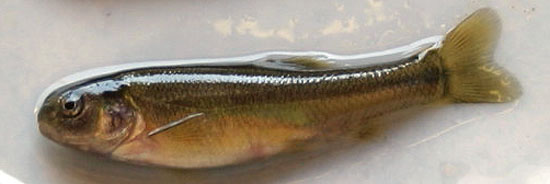| Leuciscidae (Minnows), subfamily: Pogonichthyinae |
| 10.1 cm TL (male/unsexed); max. reported age: 5 years |
|
demersal; freshwater |
| North and Central America: Over much of North America from Quebec to Northwest Territories and British Columbia in Canada and south to Alabama, Texas in USA, and Mexico. Widely introduced, including in Colorado River drainage in Arizona and New Mexico, USA. Not present on Atlantic and Gulf slopes between Potomac River in Virginia and Trinity River in Texas. Several countries report adverse ecological impact after introduction. |
|
Dorsal spines (total): 0-0; Dorsal soft rays (total): 8-8; Anal spines: 0-0; Anal soft rays: 7-7. The only species of genus introduced to Europe which differs from other cyprinid species in Europe by the following characters: prominent pad of spongy tissue on nape in males; dorsal fin origin about above pelvic fin origin; anal fin with 7½ branched rays; second simple dorsal ray spinous, about 50% length of the third one; lateral line incomplete, usually not reaching dorsal origin; weak midlateral stripe; 41-54 + 2 scales in midlateral row; and mouth terminal (Ref. 59043). |
| Inhabits muddy pools of headwaters, creeks, small rivers, and ponds (Ref. 5723, 86798). Also found in lakes (Ref. 10294). Can tolerate conditions (e.g., turbid, hot, poorly oxygenated, intermittent streams) unsuitable for most fishes (Ref. 5723, 86798). Feeds on detritus and algae (Ref. 10294). Spawns in still-water habitats along shores (Ref. 59043). Introductions consequently caused the spread of the enteric red-mouth disease throughout northern Europe which infected wild and cultured trouts and eels (Ref. 1739). Maintained a relatively high metabolic rate and level of activity under hypoxic conditions (Ref. 77050). Individuals that survived the hypoxic conditions during winter had rapid growth rates after ice-off (Ref. 77048). |
|
Least Concern (LC); Date assessed: 02 July 2018 Ref. (130435)
|
| potential pest |
Source and more info: www.fishbase.org. For personal, classroom, and other internal use only. Not for publication.

